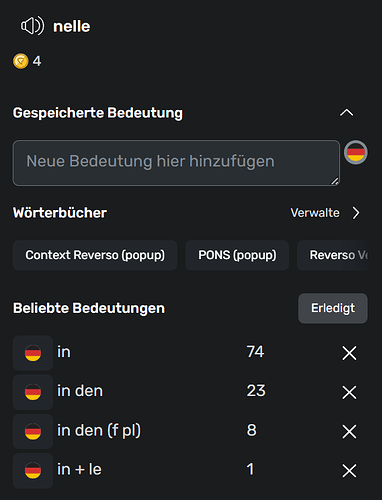Dear community,
I’m not sure if this has been discussed - I could not find anything searching the forum. I see a problem with the translations of single words that multiply especially with new learners (like myself) that have no way of knowing better and just choosing the first translation, which is in many cases wrong.
Whenever you click a word, the “meanings” (translations - don’t know what the english client says, in German it’s “Beliebte Bedeutungen” … “popular meanings”) are displayed and ranked according to their “popularity”.
Users can add their own translations, so there is a variety of translations available to you, but many of them are simply false. For that purpose, the “report” button has been included. But I have a feeling there are ten times more false translations added than flagged as false with the report function.
Here is one simple example from my italian learning - sorry for theh long explanation: The italian preposition “nelle” is composed of “in + le” (article for feminine plural) and its meaning is "in the … " but in plural feminine (hard to translate that in english).
The most popular suggestion (74) is basically wrong because especially when learning the vocabulary there is no hint of composition or plural. “in” directly translated to italian without m/f or sg/pl is “in”, not “nelle”.
The second one (23) is basically correct, but doesn’t tell you it’s feminin (or plural). Might as well be the translation from “nel” or “nello” (masculine)
The third one (8) is the best, clearly states in brackets (f pl), feminine plural - unmistakable.
The fourth one (1) again is wrong, yes - “nelle” is composed of “in” + “le” but that’s not the meaning, it’s just the grammatical explanation.
In many other cases, users even add the italian word to the translation, that’s not useful in repetitions of the vocabulary, when the solution is already in the question…
Long story short:
My example is one of MANY! I would guess that’s the case for 10-20% of the nouns, around 30% of the verbs in precise coniugations and maybe even 50+% in the more difficult translations like composed prepositions and so on.
How should a new learner know which of the 4 in my examples is really the correct one?
How could we improve that in the future?
I do not want to learn “popular” translations (that are 100% false), I want to learn correct ones.
I have stopped to blindly add the proposed translations and look up everything in solid sources like PONS.
